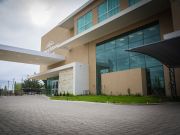The Central Park and the Av Argentina in Neuquén See map
Neuquén capital city was built, like most other towns in Patagonia, about the arrival of the railroad. For this reason we can see the city over the railroad tracks from east to west and in the commercial center of town is the Central Park on the train tracks and divided by the Avenue Argentina.
The Central Park is larger green space of Neuquén, which opened in 1986 on land occupied by facilities of Ferrocarril del Sud. The park stretches from the street Tucumán/Tierra del Fuego to the street Salta/Lainez in east-west direction. The streets have two names because they change their name on the tracks, the first name is from the north and the second from the south. The central park is an ideal space for outdoor sports and to relax and enjoy the place.
Within the ground there are different buildings operating in the old railway facilities. Among them is the former machine shed Ferrocarril del Sud, opened in 1901, recycled and provincial interest declared in 1986, where now the Gregorio Alvarez Museum. Also there are the former parcel shed, which houses the Theatre Hall Alicia Fernandez Rego, the former freight yard where works in the Exhibition and Municipal Art Hall Saraco Emilio and the former home of the Colony Railroad which houses the Paraje Confluence Museum.
In its almost 20 hectares you will also find the Monument to the Fallen in Falklands, which opened on September 26, 2006 under the 102 anniversary of the town. The monument consists of a square, a reminder to the 649 killed in the war, three masts with flags of Argentina, Neuquén and the Falklands, and a waterfall symbolizing the union.
They are also in place the Monument "Centennial of the City of Neuquén", which is a sculptural piece of major proportions. It has spheres of different colors as a symbol of universality and ethnic integration of Neuquén which are supported on a moebius treadmill that depicts the "infinity" (referring to the unlimited development of the city) and end up in a curtain of water of 5 meters high which means the junction of the rivers Limay and Neuquén. The monument is on Av Oascoaga to Mitre height, while the Monument to the Mother is on Av Olascoaga and Vuelta de Obligado. The latter was donated by the Police of Neuquén and was inaugurated in 1965 to be held on the police's day. The monument is a realistic and figurative sculpture depicting a mother with her child as a symbol of surrender to life and protection.
Last but not least, we find the National Museum of Fine Arts in the Park on street Mitre.
Traveling Argentina Avenue in south-north direction
- Monument Centennial of the City of Neuquén. Av. Oascoaga and Mitre.
- Monumet to the Mother. Av Argentina and Vuelta de Obligado.
- Fountain La Cibeles. Av Argentina and Independencia.
- Monument to Eva Perón. Av Argentina 130.
- Cathedral María Auxiliadora. Av Argentina 162.
- Chapel Nuestra Sra. de los Dolores. Av Argentina 164.
- Monument to Domingo Faustino Sarmiento. Av Argentina 200.
- Monument to General San Martín. Av Argentina and Roca.
- Municipality of Neuquén. Av Argentina and Roca.
- Foundational Monolith. Av Argentina and Roca.
- Commando of the 6th Mountain Infantry Brigade. Av Argentina and Sargento Cabral.
- Cristo de la Hermandad. Av Argentina 1600.
- Monument and Mausoleum of Colonel Olascoaga. Av Argentina 1600.
- Centennial Square. Av Argentina 1700.
- Viewpoint Balcón del Valle. North Park.
- Astronomical Observatory. North Park.
Alojamiento en Neuquen
 Hotel Howard Johnson by Wyndham
A minutos del Aeropuerto Internacional Presidente Perón, de las empresas de la zona y de museos históricos.ver másTel: (0299) 15 4228853Neuquen
Hotel Howard Johnson by Wyndham
A minutos del Aeropuerto Internacional Presidente Perón, de las empresas de la zona y de museos históricos.ver másTel: (0299) 15 4228853NeuquenViajes por la Patagonia
Related Articles
© Patagonia.com.ar 2025 | Todos los derechos reservados.
